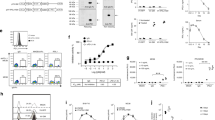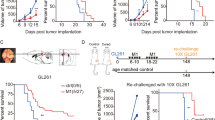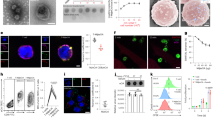Abstract
In situ tumor cell killing by the herpes simplex virus thymidine kinase (HSVtk) gene can effectively prime antitumor T-cell responses, at least in part through local induction of a pro-inflammatory environment. Therefore, we reasoned that tumor-associated HSVtk expression would significantly enhance the efficacy of adoptive T-cell transfer (ACT) of (tumor) antigen-specific T cells into tumor-bearing hosts. When B16ovaHSVtk tumors were treated with ganciclovir (GCV), along with suboptimal numbers of activated OT-1T cells, complete tumor regressions were observed where GCV, or ACT, alone was completely ineffective. To our surprise, analysis of regressing tumors showed no increases in intratumoral OT-1T cell trafficking. However, the intratumoral percentages of both OT-1 and endogenous natural killer (NK) cells were substantially increased over controls. Depletion of endogenous NK cells abrogated the efficacy of the combination therapy and reduced the percentages of interferon-γ(IFNγ)-secreting OT-1T cells in mice that received combined therapy to levels similar to those of control mice. These data suggest that even relatively low levels of gene transfer of suicide genes into tumors may have therapeutic value as an adjuvant for other T-cell therapies, by providing immunological signals that support T-cell activation and expansion in vivo.
This is a preview of subscription content, access via your institution
Access options
Subscribe to this journal
Receive 12 print issues and online access
$259.00 per year
only $21.58 per issue
Buy this article
- Purchase on Springer Link
- Instant access to full article PDF
Prices may be subject to local taxes which are calculated during checkout






Similar content being viewed by others
References
Rosenberg SA, Yang JC, Restifo NP . Cancer immunotherapy: moving beyond current vaccines. Nat Med 2004; 10: 909–915.
Dudley ME, Wunderlich JR, Robbins PF, Yang JC, Hwu P, Schwartzentruber DJ et al. Cancer regression and autoimmunity in patients after clonal repopulation with antitumor lymphocytes. Science 2002; 298: 850–854.
Rosenberg SA, Dudley ME . Cancer regression in patients with metastatic melanoma after the transfer of autologous antitumor lymphocytes. Proc Natl Acad Sci USA 2004; 101: 14639–14645.
Morgan RA, Dudley ME, Wunderlich JR, Hughes MS, Yang JC, Sherry RM et al. Cancer regression in patients after transfer of genetically engineered lymphocytes. Science 2006; 314: 126–129.
Yee C, Thompson JA, Byrd D, Riddell SR, Roche P, Celis E et al. Adoptive T cell therapy using antigen-specific CD8+ T cell clones for the treatment of patients with metastatic melanoma: in vivo persistence, migration, and antitumor effect of transferred T cells. Proc Natl Acad Sci USA 2002; 99: 16168–16173.
Dudley ME, Rosenberg SA . Adoptive-cell-transfer therapy for the treatment of patients with cancer. Nat Rev Cancer 2003; 3: 666–675.
Gattinoni L, Finkelstein SE, Klebanoff CA, Antony PA, Palmer DC, Spiess PJ et al. Removal of homeostatic cytokine sinks by lymphodepletion enhances the efficacy of adoptively transferred tumor-specific CD8+ T cells. J Exp Med 2005; 202: 907–912.
Gattinoni L, Klebanoff CA, Palmer DC, Wrzesinski C, Kerstann K, Yu Z et al. Acquisition of full effector function in vitro paradoxically impairs the in vivo antitumor efficacy of adoptively transferred CD8+ T cells. J Clin Invest 2005; 115: 1616–1626.
Zou W . Immunosuppressive networks in the tumour environment and their therapeutic relevance. Nat Rev Cancer 2005; 5: 263–274.
Moolten FL, Wells JM, Heyman RA, Evans RM . Lymphoma regression induced by ganciclovir in mice bearing a herpes thymidine kinase transgene. Hum Gene Ther 1990; 1: 125–134.
Moolten FL, Wells JM . Curability of tumors bearing herpes thymidine kinase genes transferred by retroviral vectors. J Natl Cancer Inst 1990; 82: 297–300.
Fillat C, Carrio M, Cascante A, Sangro B . Suicide gene therapy mediated by the herpes simplex virus thymidine kinase gene/ganciclovir system: fifteen years of application. Curr Gene Ther 2003; 3: 13–26.
Melcher A, Todryk S, Hardwick N, Ford M, Jacobson M, Vile RG . Tumor immunogenicity is determined by the mechanism of cell death via induction of heat shock protein expression. Nat Med 1998; 4: 581–587.
Todryk S, Melcher AA, Hardwick N, Linardakis E, Bateman A, Colombo MP et al. Heat shock protein 70 induced during tumor cell killing induces Th1 cytokines and targets immature dendritic cell precursors to enhance antigen uptake. J Immunol 1999; 163: 1398–1408.
Vile RG, Castleden S, Marshall J, Camplejohn R, Upton C, Chong H . Generation of an anti-tumour immune response in a non-immunogenic tumour: HSVtk killing in vivo stimulates a mononuclear cell infiltrate and a Th1-like profile of intratumoural cytokine expression. Int J Can 1997; 71: 267–274.
Ramesh R, Marrogi AJ, Munshi A, Abboud CN, Freeman SM . In vivo analysis of the ‘bystander effect’: a cytokine cascade. Exp Hematol 1996; 24: 829–838.
Freeman SM, Ramesh R, Marrogi AJ . Immune system in suicide-gene therapy. Lancet 1997; 349: 2–3.
Felzmann T, Ramsey WJ, Blaese RM . Characterization of the antitumor immune response generated by treatment of murine tumors with recombinant adenoviruses expressing HSVtk, IL-2, IL-6 or B7-1. Gene Therapy 1997; 4: 1322–1329.
Satoh T, Teh BS, Timme TL, Mai WY, Gdor Y, Kusaka N et al. Enhanced systemic T-cell activation after in situ gene therapy with radiotherapy in prostate cancer patients. Int J Radiat Oncol Biol Phys 2004; 59: 562–571.
Miles BJ, Shalev M, Aguilar-Cordova E, Timme TL, Lee HM, Yang G et al. Prostate-specific antigen response and systemic T cell activation after in situ gene therapy in prostate cancer patients failing radiotherapy. Hum Gene Ther 2001; 12: 1955–1967.
Sterman DH, Kaiser LR, Albelda SM . Gene therapy for malignant pleural mesothelioma. Hematol Oncol Clin N Am 1998; 12: 553–568.
Klatzmann D, Valery CA, Bensimon G, Marro B, Boyer O, Mokhtari K et al. A phase I/II study of herpes simplex virus type 1 thymidine kinase ‘suicide’ gene therapy for recurrent glioblastoma. Study Group on Gene Therapy for Glioblastoma. Hum Gene Ther 1998; 9: 2595–2604.
Klatzmann D, Cherin P, Bensimon G, Boyer O, Coutellier A, Charlotte F et al. A phase I/II dose-escalation study of herpes simplex virus type 1 thymidine kinase ‘suicide’ gene therapy for metastatic melanoma. Study Group on Gene Therapy of Metastatic Melanoma. Hum Gene Ther 1998; 9: 2585–2594.
Prados MD, McDermott M, Chang SM, Wilson CB, Fick J, Culver KW et al. Treatment of progressive or recurrent glioblastoma multiforme in adults with herpes simplex virus thymidine kinase gene vector-producer cells followed by intravenous ganciclovir administration: a phase I/II multi-institutional trial. J Neurooncol 2003; 65: 269–278.
Teh BS, Aguilar-Cordova E, Kernen K, Chou CC, Shalev M, Vlachaki MT et al. Phase I/II trial evaluating combined radiotherapy and in situ gene therapy with or without hormonal therapy in the treatment of prostate cancer – a preliminary report. Int J Radiat Oncol Biol Phys 2001; 51: 605–613.
Rainov NG . A phase III clinical evaluation of herpes simplex virus type 1 thymidine kinase and ganciclovir gene therapy as an adjuvant to surgical resection and radiation in adults with previously untreated glioblastoma multiforme. Hum Gene Ther 2000; 11: 2389–2401.
Harrington K, Alvarez-Vallina L, Crittenden M, Gough M, Chong H, Diaz RM et al. Cells as vehicles for cancer gene therapy: the missing link between targeted vectors and systemic delivery? Hum Gene Ther 2002; 13: 1263–1280.
Thomas DA, Massague J . TGF-beta directly targets cytotoxic T cell functions during tumor evasion of immune surveillance. Cancer Cell 2005; 8: 369–380.
Fisher DT, Chen Q, Appenheimer MM, Skitzki J, Wang WC, Odunsi K et al. Hurdles to lymphocyte trafficking in the tumor microenvironment: implications for effective immunotherapy. Immunol Invest 2006; 35: 251–277.
Cole C, Qiao J, Kottke T, Diaz RM, Ahmed A, Sanchez-Perez L et al. Tumor-targeted, systemic delivery of therapeutic viral vectors using hitchhiking on antigen-specific T cells. Nat Med 2005; 11: 1073–1081.
Kottke T, Qiao J, Diaz RM, Ahmed A, Vroman B, Thompson J et al. The perforin-dependent immunological synapse allows T-cell activation-dependent tumor targeting by MLV vector particles. Gene Ther 2006; 13: 1166–1177.
McCormick F . Cancer gene therapy: fringe or cutting edge? Nat Rev Cancer 2001; 1: 130–141.
Overwijk WW, Theoret MR, Finkelstein SE, Surman DR, de Jong LA, Vyth-Dreese FA et al. Tumor regression and autoimmunity after reversal of a functionally tolerant state of self-reactive CD8+ T cells. J Exp Med 2003; 198: 569–580.
Hogquist KA, Jameson SC, Heath WR, Howard JL, Bevan MJ, Carbone FR . T cell receptor antagonist peptides induce positive selection. Cell 1994; 76: 17–27.
Smyth MJ, Cretney E, Takeda K, Wiltrout RH, Sedger LM, Kayagaki N et al. Tumor necrosis factor-related apoptosis-inducing ligand (TRAIL) contributes to interferon gamma-dependent natural killer cell protection from tumor metastasis. J Exp Med 2001; 193: 661–670.
Kim A, Noh YW, Kim KD, Jang YS, Choe YK, Lim JS . Activated natural killer cell-mediated immunity is required for the inhibition of tumor metastasis by dendritic cell vaccination. Exp Mol Med 2004; 36: 428–443.
Takeda K, Smyth MJ, Cretney E, Hayakawa Y, Kayagaki N, Yagita H et al. Critical role for tumor necrosis factor-related apoptosis-inducing ligand in immune surveillance against tumor development. J Exp Med 2002; 195: 161–169.
Hanson HL, Donermeyer DL, Ikeda H, White JM, Shankaran V, Old LJ et al. Eradication of established tumors by CD8+ T cell adoptive immunotherapy. Immunity 2000; 13: 265–276.
Melcher A, Gough M, Todryk S, Vile R . Apoptosis or necrosis for tumor immunotherapy: what's in a name? J Mol Med 1999; 77: 824–833.
Nguyen KB, Salazar-Mather TP, Dalod MY, Van Deusen JB, Wei XQ, Liew FY et al. Coordinated and distinct roles for IFN-alpha beta, IL-12, and IL-15 regulation of NK cell responses to viral infection. J Immunol 2002; 169: 4279–4287.
Smyth MJ, Cretney E, Kelly JM, Westwood JA, Street SE, Yagita H et al. Activation of NK cell cytotoxicity. Mol Immunol 2005; 42: 501–510.
Markowitz D, Goff S, Bank A . Construction of a safe and efficient retrovirus packaging cell line. Adv Exp Med Biol 1988; 241: 35–40.
Coligan JE, Kruisbeek AM, Margulies DH, Shevach EM, Strober W . Isolation of mouse mononuclear cells. John Wiley and Sons, Inc.: New York, 1998.
Bland JM, Altman DG . The logrank test. Br Med J 2004; 328: 1073.
Acknowledgements
We are grateful to Toni Higgins for expert secretarial assistance. We thank Dr Ron Marler and Leslie Dixon for the pathology analysis and Bruce Morlan for the statistical analysis. This work was supported by the Mayo Foundation and by NIH Grants 1RO1CA94180 and 1RO1CA107082.
Author information
Authors and Affiliations
Corresponding author
Rights and permissions
About this article
Cite this article
Sanchez-Perez, L., Gough, M., Qiao, J. et al. Synergy of adoptive T-cell therapy and intratumoral suicide gene therapy is mediated by host NK cells. Gene Ther 14, 998–1009 (2007). https://doi.org/10.1038/sj.gt.3302935
Received:
Revised:
Accepted:
Published:
Issue Date:
DOI: https://doi.org/10.1038/sj.gt.3302935
Keywords
This article is cited by
-
Functional Cloning of Recurrence-specific Antigens Identifies Molecular Targets to Treat Tumor Relapse
Molecular Therapy (2013)
-
Detecting and targeting tumor relapse by its resistance to innate effectors at early recurrence
Nature Medicine (2013)
-
Broad antigenic coverage induced by vaccination with virus-based cDNA libraries cures established tumors
Nature Medicine (2011)
-
The cytotoxic activity of the phage E protein suppress the growth of murine B16 melanomas in vitro and in vivo
Journal of Molecular Medicine (2009)
-
Characterization of the adaptive and innate immune response to intravenous oncolytic reovirus (Dearing type 3) during a phase I clinical trial
Gene Therapy (2008)



